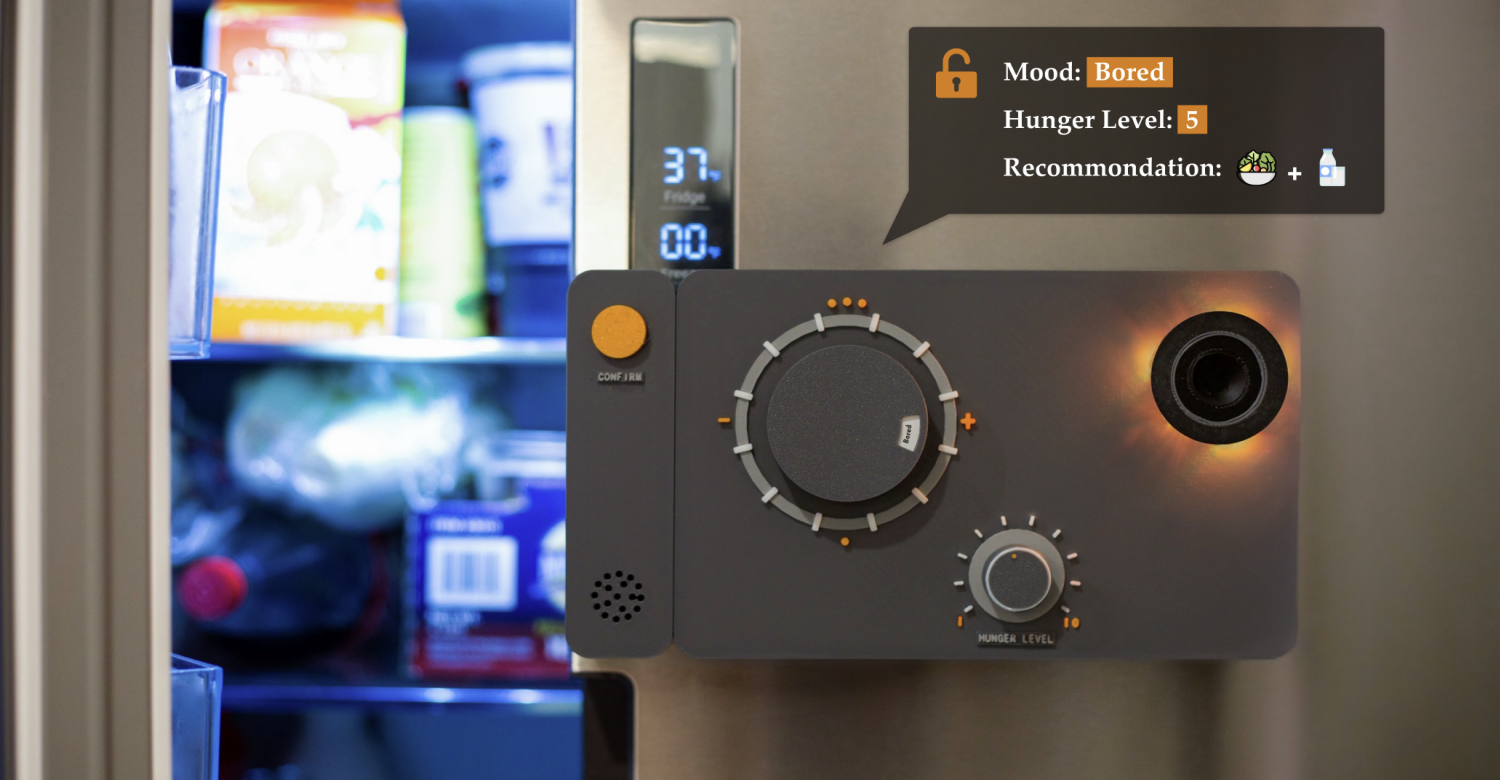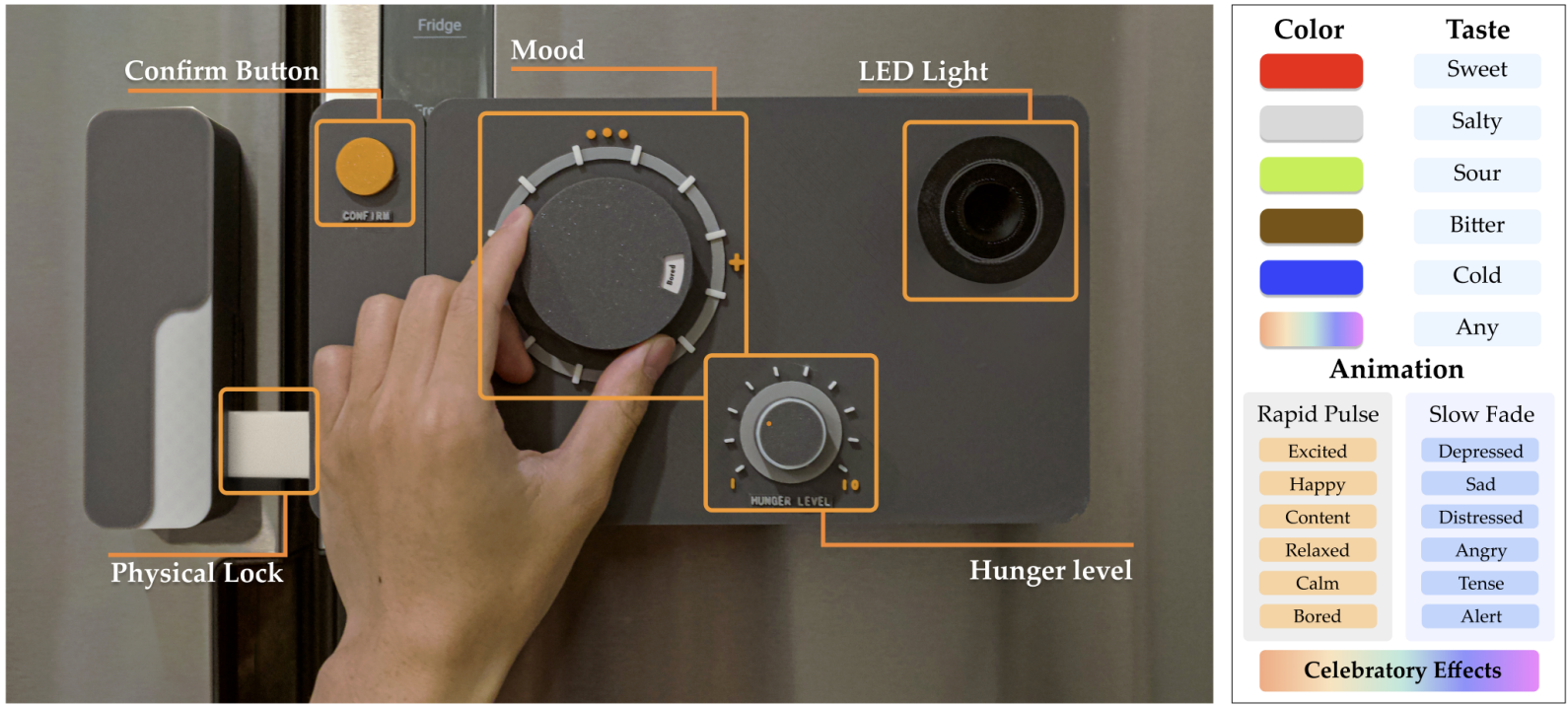Craving Checkpoint: An Interactive Fridge Lock forMindful Eating
Author: Xiaoman Yang, Carrie Wang, Zijie Zhou
Traditional dietary interventions often rely on restriction, tracking, or delayedreflection, which can limit their ability to foster lasting change. We present CRAVING CHECKPoINT, a Large Language Object (LLO) in the form of an interactive firidge lock designed as a Just-In-Time Adaptive Intervention that supportsmindful eating through embodied and emotionally expressive interaction. The system engages users at the moment of food access, prompting self-reflectionthrough mood and hunger input and offering real-time feedback through an anthro-pomorphic voice and synesthetic lighting. A large language model personalizessuggestions based on user state and behavioral patters, gently guiding healthier choices without enforcing control, By transforming food access into a shared ritual between human and machine, CRAVING CHECKPoINT explores how creative Al can support sustainable behavior change through timely, affective, and co-authoredinterventions.
KeyWords: Behavioral Intervention, Dietary Behavior Modulation, Affective Computing, Health-Related HCI
Concept Figure
Problem Definition
Traditional approaches to dietary control, such as restrictive dieting, pharmacological interventions, or physical constraints (e.g., locking refrigerators), often lead to psychological resistance and behavioral relapse. While these methods may suppress eating impulses in the short term, they frequently undermine users' sense of self-efficacy and autonomy, limiting their long-term effectiveness.
Moreover, existing dietary control tools primarily focus on functional restrictions, neglecting the emotional and cognitive aspects of users' decision-making processes. They lack mechanisms to engage users' intrinsic motivation and support mindful behavior. Therefore, there is a pressing need for a new design strategy that preserves user autonomy while guiding them toward conscious dietary decisions, facilitating sustainable behavioral change.
Introduction
Unhealthy eating often happens in small, automatic moments—like opening the fridge just out of habit. Craving Checkpoint is designed to gently intercept those moments and turn them into opportunities for reflection rather than impulse.
When you open the fridge, the system invites a quick check-in:
Mood – you select how you’re feeling (happy, calm, bored, stressed, etc.) using a simple dial.
Hunger level – on a scale of 1–10, you indicate whether you’re just a little peckish or truly hungry.
Confirm – with one more turn, you send your input to the system.
From there, Craving Checkpoint responds in three ways:
Personalized suggestions – based on your mood, hunger, and even the food available in your fridge, the system offers a tailored idea, like a refreshing drink when you’re only mildly hungry or a balanced meal option when it’s dinnertime.
Voice feedback – an anthropomorphic voice delivers the suggestion in a warm, conversational tone, making it feel more like guidance from a companion than a command.
Lighting cues – colors and animation patterns bring the advice to life. A slow, calming glow might encourage reflection, while a bright pulse signals energy and motivation.
Over time, the system also remembers your choices, offering encouragement when you stick to healthier habits and celebrating streaks with playful voice and light sequences. Even if you choose differently, it responds with gentle support instead of control.
By combining timely reflection, AI-driven personalization, and expressive feedback, Craving Checkpoint transforms the simple act of opening the fridge into a co-authored ritual—one that nudges decisions from impulse toward intention and helps build healthier routines in everyday life.
Prototype Development
Close-up view of the interface prototype Version 1.0
The main control
unit features modular dials and symbolic input
cubes, requiring users
to input their emotional state, hunger level,
and desired food type
before unlocking access. This interaction
introduces a moment of
cognitive reflection, encouraging intentional eating behavior.
Version 2.0 Prototype
The user input has been simplified, with personalized voice feedback, synesthetic lighting feedback, and history tracking introduced.
StoryBoard
Video
Accepted to NeurIPS 2025 Creative AI track



